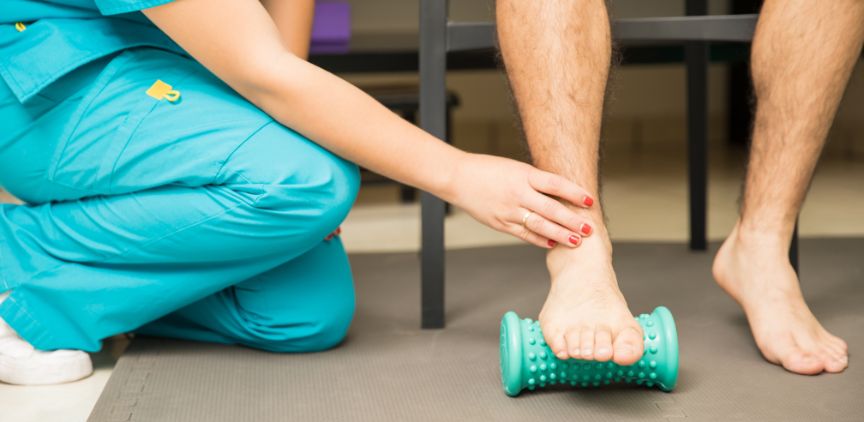Knowing the Causes Can Help Avoid Any Future Issues
Heel pain is a common complaint frequently caused by plantar fasciitis. Usually, this connective tissue supports the arch of the foot and aids in shock absorption. Yet, when it becomes inflamed, even walking can become very painful.
Treatment Options
Now that you know the plantar fasciitis causes, here are some treatment options you can try:
1. Theragun/Therabody Massage Guns
Theraguns and Therabody are both popular brands in the market of percussive therapy devices. They are one of the pioneers of this type of therapy, developing handheld massage guns that deliver rapid and powerful pulses of pressure to the muscles. Their devices are designed to help relieve tension, increase circulation and accelerate muscle recovery after workouts. The Therabody line of products includes the Theragun Pro, Elite and Mini, which vary in size and power.
Reathlete is another brand that produces similar percussive therapy devices, offering customers an affordable option that still delivers effective muscle relief. Their product line includes the Reathlete DEEP4S, DEEP4S PRO and LEGEND, which have been praised for their quiet operation and long battery life.
2. Rest
Since plantar fasciitis is typically caused by excessive stress on the feet, resting can help alleviate the pain and allow time for your body to heal and reduce inflammation.
On top of resting, it’s often recommended to modify any activities you need to perform, such as those at work or in your daily life; this may mean:
- Avoiding certain forms of exercise.
- Using athletic tape on your heels and calves for support.
- Reducing your activity, distance, or intensity of activity.
- Avoid jumping activities and opt for low-intensity options instead.
3. Switching to Shoes with more Heel Support
One way to alleviate the symptoms of Plantar Fasciitis is by switching to shoes that provide adequate heel support. Shoes with a firm and stable heel counter can help to stabilize the foot and reduce the stress on the plantar fascia. Look for shoes with a low to moderate heel and a cushioned sole to help absorb shock. Choosing shoes that fit well and provide ample arch support is also important. By making this simple switch, you can help to reduce your symptoms and improve your comfort level throughout the day. Here are some great options:
- Vivaia: Vivaia shoes are made from recycled materials and designed to be both stylish and comfortable. While they are not specifically marketed as shoes for plantar fasciitis, their unique design features such as the stretchy knit upper and cushioned sole can provide some relief for those suffering from plantar fasciitis.
- Kuru Footwear: Kuru Footwear is a brand that specializes in creating shoes with orthotic-like support for individuals suffering from foot conditions, including plantar fasciitis. Their shoes are designed with a unique "KuruSole" technology, which uses a deep heel cup and arch support to help reduce stress on the foot and promote proper alignment. Many people with plantar fasciitis have found relief in Kuru shoes, as they can help alleviate pain and discomfort while providing a comfortable and stylish option for daily wear.
- Oofos: Oofos recovery footwear is designed to provide a comfortable and supportive option for individuals recovering from various foot conditions, including plantar fasciitis. Their shoes use a unique foam technology that helps to absorb shock and reduce stress on the foot. Additionally, their shoes feature a contoured footbed that provides arch support and promotes proper alignment, which can help alleviate symptoms of plantar fasciitis.
4. Cold Therapy
Using ice wrapped in a wet towel and applied to the skin for up to 15 minutes can help you find pain relief. It may also ease inflammation, giving your body and feet a much-needed break.
5. Non-Steroidal Anti-Inflammatory Medication
This medication may help reduce your inflammation and pain. Make sure to follow any directions or instructions given to you by your doctor, and ensure you read all labels of any medication carefully before use.
6. Physical Therapy and Stretching
A physical therapist can help tailor your recovery efforts to you and your specific situation. They can also offer manual therapy, such as massage techniques, to alleviate your discomfort. Your physical therapist can further prescribe stretches to help ease your symptoms, such as the calf stretch and other exercises to help stabilize the lower leg.
Related Search Topics (Ads)
7. Night Splints
At night, your physical therapist or doctor may recommend you wear a splint to hold your Achilles tendon and plantar fascia in an elongated position while you sleep; this allows your muscles and connective tissue to stretch and may help reduce morning pain caused by plantar fasciitis.
8. Orthotics
Orthotic shoes and insoles are specially designed footwear and inserts that provide support and alleviate pain or discomfort in the feet, ankles, knees, hips and lower back. They can improve the alignment of the feet and body, relieve pressure on sensitive areas, and enhance overall comfort and mobility. Check out some great options for you:
- Protalus insoles: Protalus Insoles are orthotic inserts that are designed to provide dynamic support and cushioning to the feet. They use a patented technology called the Tri-Planar Dynamic Support System, which aims to correct foot alignment and reduce stress and strain on the body. Protalus Insoles are designed to be comfortable and versatile, fitting into a wide range of shoes and activities.
- Upstep Orthotics: Upstep Orthotics are custom-made shoe inserts that are designed to provide personalized support and comfort to the feet. They are made from high-quality materials and use advanced technology to create a customized fit tailored to each individual's unique needs. Upstep Orthotics can help to alleviate pain and discomfort, improve foot and body alignment, and enhance overall mobility and performance.
- The Insole Store: The Insole Store is an online retailer that specializes in providing a wide range of orthotic inserts and shoe accessories to help alleviate foot pain and improve comfort. They offer a variety of products, including insoles, arch supports, heel cups and shoe cushions, from top brands such as Superfeet, Powerstep and Spenco. The Insole Store is dedicated to providing high-quality products.
In more severe cases, surgery may also be an option. It is only done in extreme cases where every other treatment has yielded zero improvements. Surgery involves the detachment of the plantar fascia from the heel bone.
Plantar Fasciitis Causes
Plantar fasciitis usually arises from excessive tension and stress on the feet; this may happen due to a variety of reasons, such as repetitive stress caused by exercise. Athletes who frequently experience plantar fasciitis are involved in running and dancing activities. This condition is also common in beginner runners, dancers, or similar, especially if activities are increased too much too soon.
Plantar fasciitis causes can occur if you have flat feet. You may also be prone to plantar fasciitis due to uneven weight distribution; this can also occur when wearing shoes that aren’t appropriate for the specific activity or shoes that lack support, such as high heels.
Excessive weight, such as being obese, can also place more stress on this connective tissue, leading to pain. Lastly, individuals with occupations where they are on their feet a lot, such as teachers, construction workers, or factory workers, may also experience this condition more frequently.
Ignoring the pain and symptoms of plantar fasciitis may result in persistent heel pain and disruption in your everyday life. It can further lead to ankle, knee, hip, or back problems due to muscular and joint imbalances.
Symptoms of Plantar Fasciitis
The main plantar fasciitis symptom is stabbing pain in the heel of the foot. Often, this pain is worse first thing in the morning, after long periods of standing, or after long durations of sitting.
Other symptoms may include:
- Gradual onset of heel pain.
- Pain that ebbs off with some activity during the day.
- Pain that worsens with intense or prolonged activity, such as walking or running long distances.
- Pain increases with minimally supportive shoes.
Luckily, plantar fasciitis treatment is readily available and fairly straightforward. Below, we take a closer look at the specific treatment options for this condition.

